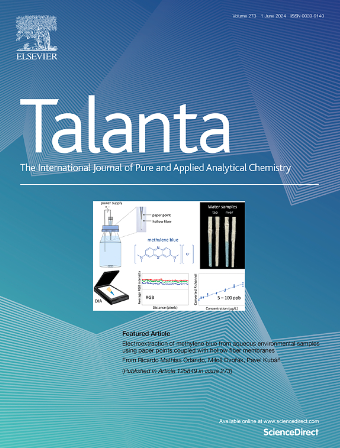Light-activated fluorescent NO donor enables spatiotemporal tracking and stomatal closure in Arabidopsis thaliana
IF 5.6
1区 化学
Q1 CHEMISTRY, ANALYTICAL
引用次数: 0
Abstract
We designed P1G3, a light-triggered NO donor from N-nitroso-naphthalene derivatives, releasing NO via N–NO cleavage while producing fluorescent P1G2 for real-time tracking. The quantity of NO released from P1G3 in the cytoplasm can be precisely regulated by light duration and light intensity, thereby minimizing the risk of unintended self-leakage in biological settings. Utilizing a quantitative mapping relationship between nitric oxide release and fluorescence intensity, we calculated for the first time the nitric oxide conversion rate of a donor system in a cellular environment. Both a method for nitric oxide quantification is proposed and the stable conversion efficiency of this donor is demonstrated. In Arabidopsis thaliana, P1G3 successfully induced Ca2+ accumulation in guard cells and triggered the gradual closure of stomata, demonstrating spatiotemporal-controlled NO delivery for enhanced drought tolerance.

光激活荧光NO供体实现拟南芥时空跟踪和气孔关闭
我们设计了n -亚硝基萘衍生物的光触发NO供体P1G3,通过N-NO裂解释放NO,同时生产荧光P1G2用于实时跟踪。P1G3在细胞质中释放的NO的数量可以通过光照时间和光照强度精确调节,从而最大限度地减少生物环境中意外自漏的风险。利用一氧化氮释放和荧光强度之间的定量映射关系,我们首次计算了细胞环境中供体系统的一氧化氮转化率。提出了一种定量测定一氧化氮的方法,并证明了该供体的稳定转化效率。在拟南芥(Arabidopsis thaliana)中,P1G3成功诱导了保护细胞中Ca2+的积累,并触发了气孔的逐渐关闭,表明时空控制的NO输送增强了耐旱性。
本文章由计算机程序翻译,如有差异,请以英文原文为准。
求助全文
约1分钟内获得全文
求助全文
来源期刊

Talanta
化学-分析化学
CiteScore
12.30
自引率
4.90%
发文量
861
审稿时长
29 days
期刊介绍:
Talanta provides a forum for the publication of original research papers, short communications, and critical reviews in all branches of pure and applied analytical chemistry. Papers are evaluated based on established guidelines, including the fundamental nature of the study, scientific novelty, substantial improvement or advantage over existing technology or methods, and demonstrated analytical applicability. Original research papers on fundamental studies, and on novel sensor and instrumentation developments, are encouraged. Novel or improved applications in areas such as clinical and biological chemistry, environmental analysis, geochemistry, materials science and engineering, and analytical platforms for omics development are welcome.
Analytical performance of methods should be determined, including interference and matrix effects, and methods should be validated by comparison with a standard method, or analysis of a certified reference material. Simple spiking recoveries may not be sufficient. The developed method should especially comprise information on selectivity, sensitivity, detection limits, accuracy, and reliability. However, applying official validation or robustness studies to a routine method or technique does not necessarily constitute novelty. Proper statistical treatment of the data should be provided. Relevant literature should be cited, including related publications by the authors, and authors should discuss how their proposed methodology compares with previously reported methods.
 求助内容:
求助内容: 应助结果提醒方式:
应助结果提醒方式:


